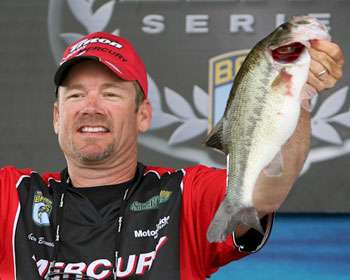
For Stephen Browning, the 2009 Elite Series season has been a little rocky. After opening the year with three Top 25 finishes, Browning stumbled in the next three events. However, during the season's seventh event, held on the Mississippi River in Iowa, getting "rocky" actually helped get his season back on track.
Keying on riprap banks, Browning was one of only two anglers to weigh in a limit all four competition days as he fished his way to fifth place. The Arkansas pro has some pointers when it comes to fishing riprap in summertime. "When I'm fishing riprap in the summer, one of the biggest things that I look for is baitfish around the riprap," explains Browning. "There's always a little algae growing on the rocks, and it gives the baitfish something to feed on."
At the Mississippi River, Browning used the baitfish pattern to clue him in to areas he needed to focus on. "I'd pull up to a stretch of riprap, make a few casts, and if I didn't see any baitfish jumping around, I could pretty much tell that it wasn't going to be a productive area," he says. For Browning, the presence of baitfish not only means there will most likely be bass in the area, but it also tells him where those bass should be positioned.
"The bait really seems to relate to the little current eddies created by the rocks. And it really positions the bass in those little indentations in the rocks," explains Browning. Just as a bass angler scouts out a cove or bay before deciding on the best spot to drop the trolling motor, Browning also does a little research before casting to riprap banks. If he is faced with a long stretch of riprap, he will position his boat as close to the bank as possible and take a long look down the bank. In doing so, Browning is immediately able to detect subtle contour changes hundreds of feet down the shore.
"There are always two or three places that will jump out, and those are the places I'll fish. On a 2-mile stretch there may only be four places that hold fish. Taking that long look directly down the bank really helps in finding those spots," he reveals.
When it comes to boat positioning, Browning almost always positions his boat parallel to the riprap if conditions will allow. By casting down the bank rather than toward the structure, he is able to maximize the time his lure is in the strike zone. "The only time I won't be right next to the bank is if I find a stretch that has a lot of fish. Then, I might back off so I'm not spooking them," he allows.
During the summer months, many productive shallow water areas are slow to replenish. Not so with riprap banks, claims Browning. "Especially if there's deep water nearby, the bass will move in, feed a little, and then pull back out from the riprap," Browning explains. "It's really a timing deal. If the baitfish are there and you hit the right area, you can really load the boat."
Depending on water clarity, Browning's go-to offering when fishing riprap is often a spinnerbait featuring either a Colorado or Oklahoma blade. If the water is dingy, he will opt for a crankbait with a wide wobble. "Koppers makes a shallow diving LiveTarget crankbait that is almost impossible to get hung up," discloses Browning. In midsummer, Browning says the ideal time to focus on riprap banks is often early in the morning. "One of the things about fishing riprap is that the water will get warmer there than it does in the rest of the lake. So if it's a hot summer day, it's a good place to start. Fish it for an hour, and when the fish quit biting, move to where the temperature is more comfortable to the fish."




